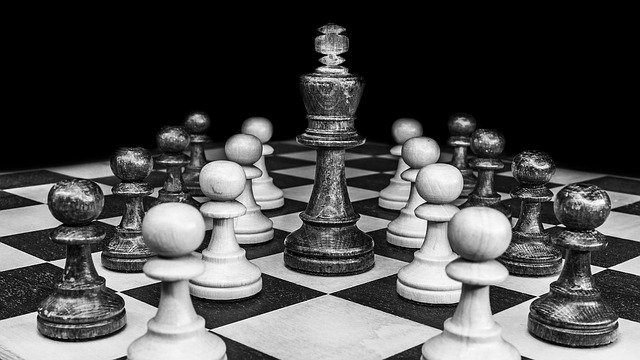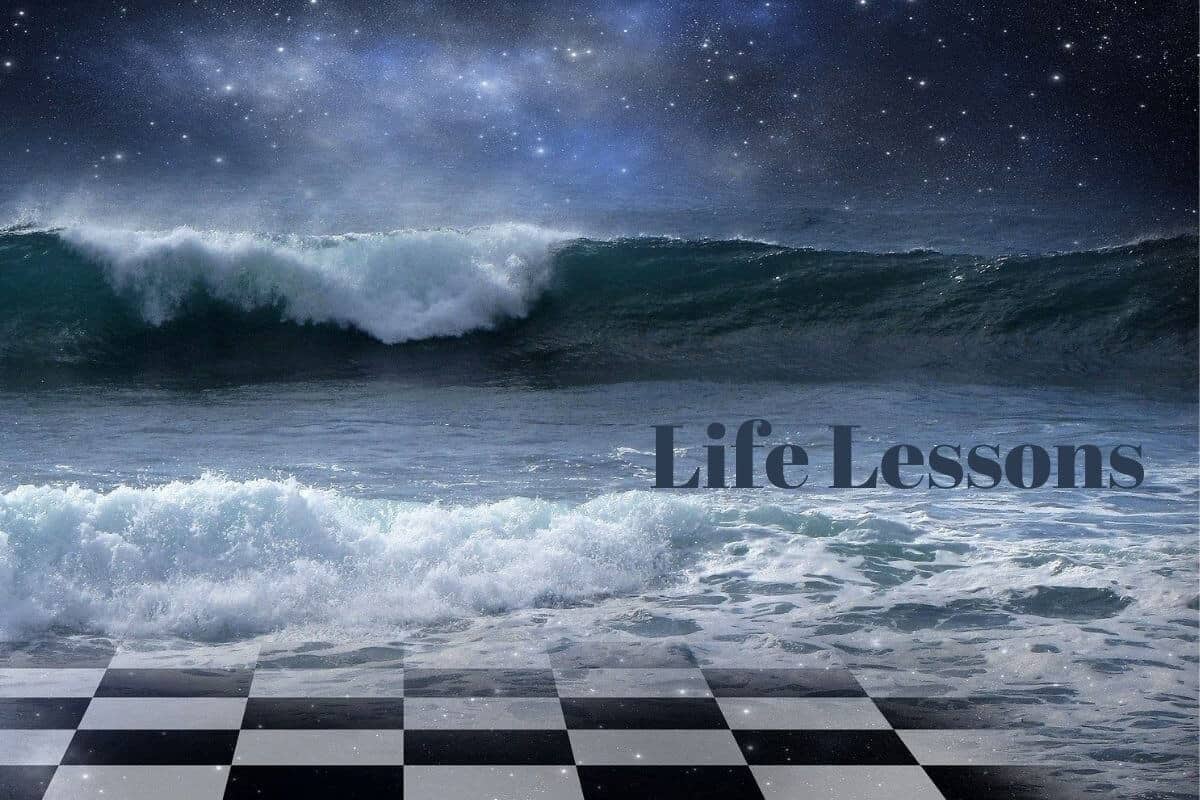Chess is played on a board with eight columns called files, each containing eight squares, and eight rows, or ranks, also containing eight squares. So, how many squares are there on a normal chessboard? The total amount of squares that are on every chess board is 204 squares.
How did we come up with this number? Well, there are many different-sized squares on the chessboard and not just the 64 identical squares. Below is a table that shows the various different-sized squares on a chessboard. All we have to do is just add them all up to get the total.
| Type Of Square | Count |
| 8×8 | 1 |
| 7×7 | 4 |
| 6×6 | 9 |
| 5×5 | 16 |
| 4×4 | 25 |
| 3×3 | 36 |
| 2×2 | 49 |
| 1×1 | 64 |
Total number of squares on a chessboard= 64 + 49 + 36 + 25 + 16 + 9 + 4 + 1= 204 squares
This 8 by 8 grid results in 64 alternating colored squares. 32 of which are light squares and 32 dark squares. All 64 squares are identical in length and the board should measure the same on all 4 sides. You need to set up the pieces on their correct squares before you start. See how to setup chessboard the right way
Setting up your pieces is pretty easy. The back row is always set up like the image below, with the King and Queen in the middle squares of the back row. The Bishops are on either side of them, then the Knights beside them, and the Rooks in the corner squares.
Diagram Showing a 64 Identical Square Chess Board: 8×8 Grid

Types Of Squares On A Chess Board
The 64-square chess board is made up of 4 different types of squares. These are:
- Center Squares
- Files
- Diagonals
- Ranks
Each chess piece moves on a different type of square and their characteristics vary.
Center Squares

The four center squares marked red (d4, d5, e4, e5) are very important because if occupied or controlled, they enable a piece to have control over the whole board. It’s principled for the pawns to occupy these central squares because they help to control the center in the initial stage of the game.
It’s important for every chess player to fight for these 4 squares if they wish to have any sort of advantage over their opponent. Not only should you fight for center squares, but you must play in the center of the board which is an important principle in chess.
In the middle game, most exchanges happen in the center squares when the tension is released. In the endgame when only pawns are left on the board, the Kings rush to the center of the board to gain more control and opposition. This is important because, from the center of the board, the King can support his pawns up the board, attack enemy pawns and at the same time prevent the enemy king from accessing crucial squares in your camp.
Here is a perfect example of a game that demonstrates the importance of occupying the central squares and how one player suffered from breaking that principle in the blink of an eye.
Files

Squares running from top to bottom are called files. The pawns usually move along the files in a forward direction. In chess, it’s important to open up files for your Rooks because they move vertically and horizontally. You can open up files by exchanging pawns in the center of the board.
Leaving a file closed can cause your rooks to remain passive and they won’t co-ordinate well. With an open file, the rook can move up and down the board freely and attack weak enemy pawns that are backward and isolated.
An open file is not only controlled by a single Rook. It can also be controlled by two Rooks and even a Queen. The two Rooks and a Queen on the open file create what is known as an Alekhine gun.
Ranks
Squares running from left to right are called ranks. You have the back ranks, the seventh ranks (a.k.a seventh heaven), 3rd, 4th, 5th, and 6th ranks. Similarly to files, the Rooks need access to ranks, especially the seventh ranks where the enemy pawns are a target.
The seventh rank is deep into your opponent’s territory and is where your opponent’s pawns begin their journey. If you can get both your Rooks on to that seventh rank, you will gain a lot of power. They will work together and gobble up any other piece in their path.
The Seventh Heaven

Its seventh heaven and the two rooks have complete dominance over the 7th rank. The two rooks are able to zoom up and down the seventh rank and chop off all the pawns. All in all Rooks on the 7th rank give you much greater chances to win.
Diagonals

Squares running diagonally are called diagonals. There are 26 diagonals in total. The longest diagonals are A1-H8 and A8-H1. The bishops usually move along the diagonals of the chessboard up and down.
If you can get two bishops on their open diagonals in harmony with one another, then you may have a great advantage over your opponent. The two Bishops on their longest diagonals can slice the board and eliminate any piece that comes in their way.
Bishops on long diagonals are a great way to pin enemy pieces and create tension. Pinning the enemy pieces will limit your opponent’s activity and in turn, increase the activity of your pieces.
How Are The Squares Identified
Every 64 square on a chessboard has a unique identifier and each piece has its own outline shape, which you see used in chess quizzes on computers and in newspapers. The squares are identified by a number and letter of the alphabet. Letters run across the chessboard horizontally. These are a, b, c, d, e, f, g, h, while numbers run up the chessboard and are numbered 1, 2, 3, 4, 5, 6, 7, 8.
All 8 numbers and 8 letters that run up and across the chessboard helps to identify a particular square on the chessboard. The alphabet is placed before the number. For example a1. There are also two sides to a chessboard. The side that has the King is called the Kingside and the side that has the Queen is called the Queenside. This helps to denote when a King decides to castle Kingside or Queenside.

- Purple: File
- Yellow: Rank
- Brown: Diagonal
- Red: Central Squares
Size and Color of the Chess Squares
According to the United States Chess Federation, the size of each individual square on a chessboard should be anywhere between 2 inches to 2.5 inches in length. All squares are identical in length and the colors alternate on the 8*8 grid.
The colors are not subjective but the most popular colors used are black and white. Colors should be used appropriately. Sometimes a brightly colored chessboard can affect the mood of the player and throw them off from concentrating.
Here is a list of acceptable colored squares that can be used on the chessboard:
- Blue
- Grey
- Maple
- Teak
- Cherry
- Pine
- Green Marble
- Brown Marble
- Metal
These are just some of the colors that can be used on the chessboard. Just remember that brightly colored chess boards are not appropriate. (Example yellow, red, bright orange, bright purple)
Other Variants Of Chess
We’ve looked at the number of squares on an 8 by 8 grid chessboard. But did you know that you had different size chess boards with different numbers of squares? If you’ve read my article, where was chess invented, you will see that there were several variants of chess for different countries played back in the older days.
For example, the variant of chess in Mongolia was known as Shatar which consisted of a large 10 by 10 board. The chess pieces were named differently and they depicted the names of animals. For example, Bishop was called Camel and the Queen was called the Dog(Guardian)
The table below shows the different variants of chess, the grid size of a chessboard, and the total number of identical squares.
| Country | Variant Of Chess | Grid size of a chessboard | Total number of identical squares |
| India | Chaturanga | 8×8 | 64 |
| Dasapada chessboard | 10×10 | 100 | |
| Saturankam chess board | 9×9 | 81 | |
| Japan | Shogi | 9×9 | 81 |
| Dai Shogi | 15×15 | 225 | |
| Chu Shogi | 12×12 | 144 | |
| Mongolia | Hiashatar | 10×10 | 100 |
Summary – Total Number Of Identical Squares On a 8×8 Chess board
| Type of Squares | Total number |
| Ranks | 8 |
| Files | 8 |
| Central Squares | 16 |
| Diagonals | 26 |
Total Number Of Identical Squares on 8×8 chess board= # of Ranks × # of Files= 8*8= 64 identical squares
In the game of chess, it’s important to control as many squares as you can to gain power and control over the board. You gain control over squares by developing your pieces, especially towards the center of the board. Sometimes it means sacrificing a piece just to gain more activity.
If you obey this one principle, you can get great attacking chances as early as the opening, because your army is fully loaded and ready to penetrate into enemy territory.
See a full list of the top 8 by 8 grid chessboards under $100



